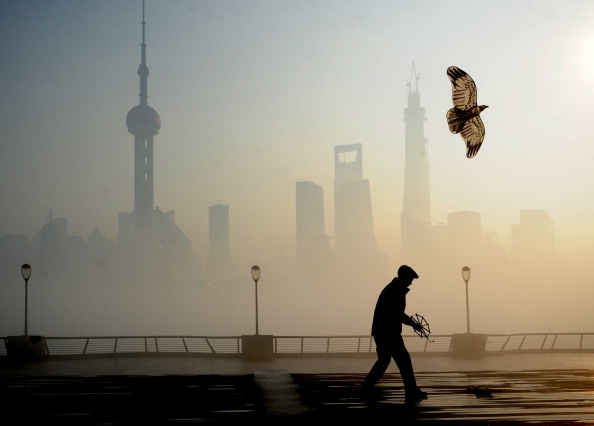
A man walks along an empty highway in China, closed due to intense smog levels (Photo: g_yulong via flickr).
After an overwhelming majority of China’s urban centers failed to meet environmental standards in 2013, Premier Li Keqiang declared a “war on pollution,” promising to improve the country’s blanketing smog endemic.
In his report to parliament on Mar. 5, Premier Li Keqiang said he would fight to eliminate the air pollution problem that shrouds 95 percent of China’s largest cities, around 700 million people, in a thick haze almost daily. His declaration comes after 71 of 74 cities failed to meet environmental standards set by the government for 2013. The three cities that did meet standards, Haikou, Lhasa and Zhoushan, are home to only 3.7 million citizens total.
As China’s dense smog increases, the health consequences are clear.
According to the World Health Organization, fine particulate air exposure should be limited to an average of 10 micrograms per cubic meter a year. Bloomberg reported levels 15 times higher in China’s 20 dirtiest cities. The Lancet, a leading medical journal, said long-term risks of increased air pollution exposure include ischemic heart disease, stroke and lung cancer. The journal cited a study that said, “Air pollution contributed to 1.2 million premature deaths in China in 2010.”
Although China has seen skyrocketing economic improvement over the past few decades, it is now paying the price for its rapid industrialization.
Wu Xiaoqing, China’s vice-minister of environmental protection, told Reuters, “When we were chasing GDP growth, we were also paying the price of pollution, and this price is heavy, is massive,”
The factories and coal plants that are powering China’s economic machine are also pumping millions of tons of coal into the atmosphere a year.

Steel mills blowing smoke in China’s industrial city, Benxi (Photo: Architecture of Life via Flickr).
For example, China’s three main industrial regions — Beijing, Hebei and Tianjin — produce 55 percent of the nation’s steel, 40 percent of its cement and 52 percent of its gasoline and diesel. These regions, just eight percent of China’s territory, also produce 30 percent of its total pollution.
The public focus on environmental issues in parliament was, at least partly, brought by citizen pressure. Citizens tired of wearing surgical masks to filter air particles while being promised better air quality, and seeing little signs of improvement, have taken to the streets to urge their officials. “Beneath a gray stain of smog,” Henry Grabar wrote for Salon, pollution has become “China’s most powerful source of social unrest,” sparking around 50,000 protests a year.
In response, Beijing increased its budget for environmental protection to $49 billion in 2013, and that number is likely to increase this year.
China also noted a tougher Environmental Protection Law (EPL) as one plan of action that’s key to reining in the pollution problem, though its environment ministry has been historically ineffective at enforcing anti-pollution policies
China’s war on pollution is not a new fight, but something that’s been talked about for years, without being strictly enforced. In 1989, China enacted the EPL for the purpose of “protecting and improving people’s environment” and “preventing and controlling pollution and other public hazards.”
The law allows for governments to “give awards” to individuals and companies that meet standards for reducing pollution and levy fees and taxes on those who contribute to the problem. Though Chinese officials did not explain how they would toughen the EPL, sources said new provisions would allow regulators to suspend and shut down repeat pollution offenders.
China’s slow attempt at cutting pollution over the years is evident in its position on stopping global climate change.
In a 2011 publication on its government website, China said their stance on climate change is to uphold the principle of “common but differentiated responsibilities.”
Chinese officials believe that developed countries should “lead in shouldering the historical responsibilities” to reduce harmful emissions “during their 200-odd years of industrialization, which is the main reason for the current global warming.”
Their stance is to develop themselves sustainably so not to “compromise the development capacity of future generations,” but they hold current economic improvement and poverty alleviation as equally important.
China holds true to this view by the coal-fired plants that continue to power the country forward and their world-leading investment in renewable energy.
According to Ethan Zindler, head analyst for the America’s at Bloomberg New Energy Finance, China led the world in 2013 by putting $61 billion towards renewable energy technologies–no country built more solar panels and wind turbines than China last year.
Another solution already being implemented, for better or worse, is outsourcing coal-fired power plants to China’s western regions, mainly populated by the minority Uighur group. Via ultra-high voltage power lines, China has begun shipping energy burnt in the west back to its industrial regions in the east, allowing for thousands of power plants there to shut down.
Bloomberg reported the story of Ani Yetahon, a man who lives 1,800 miles from Beijing and says many from his village have suffered since a $2.1 billion coal plant began operating nearby in August 2013.
“They don’t care if our children get sick or how much the pollution is affecting our village,” Yetahon said in the report. “If we do nothing, then we live with the pollution and the damage to our health.”
Chinese officials also have a band-aid solution for lifting the smog when they need a visible day. When there are special government events, China deploys smog-fighting drones that spread chemicals dispersing pollutants away.
For its citizens, the lift in haze is a break from the harmful pollutants forced in their lungs almost daily. It’s also a clear reminder of their nation’s beauty, if only for a moment, until the smog creeps back in.